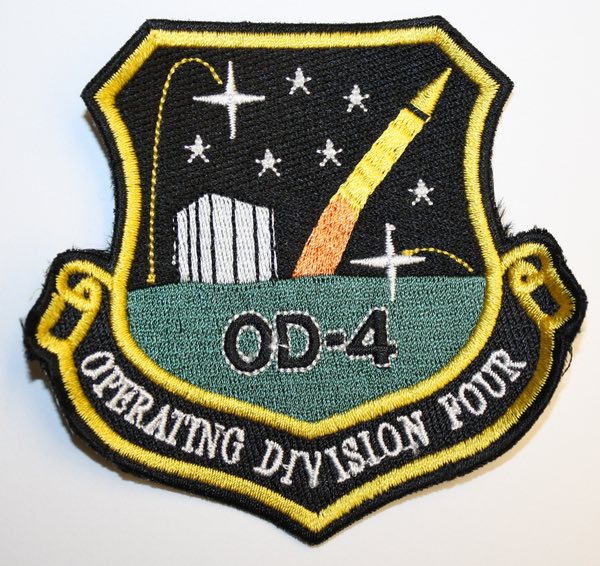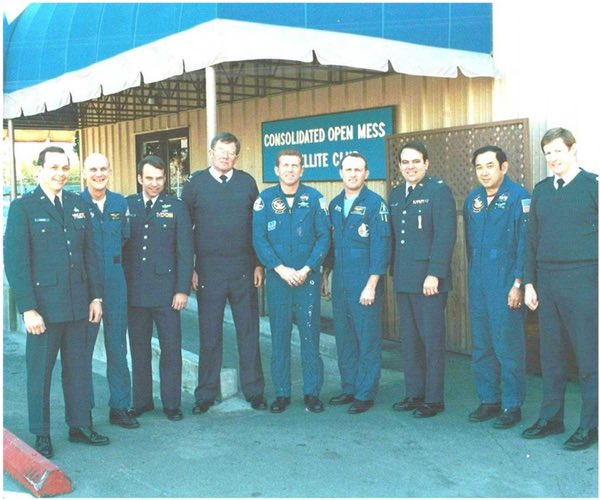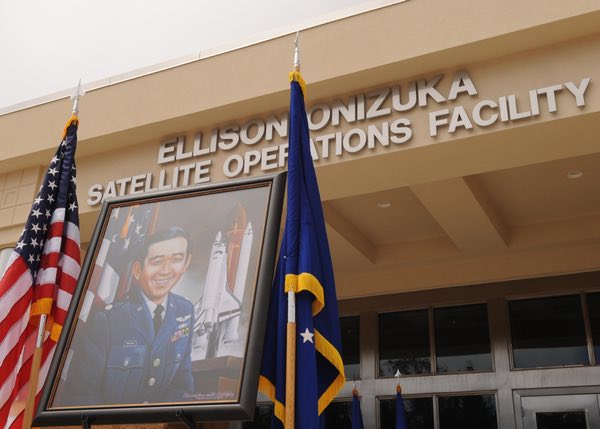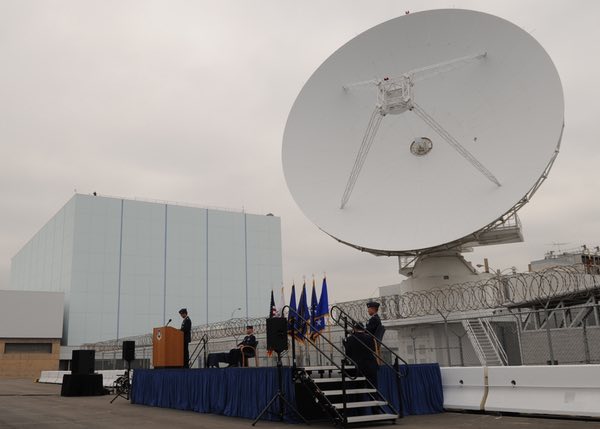To look out from a higher plateau: the naming of Onizuka Air Force Stationby Joseph T. Page II
|
| Rumors of the operations at Sunnyvale had been an open secret for years before the launch. Even today, the full history of the base has remained obfuscated. |
In the months following the Challenger disaster, the deceased crewmembers were memorialized in a variety of ways. Names were added to the Astronaut Memorial in Florida, schools were renamed for individual crew members, and university buildings took monikers recognizing the sacrifice of formerly graduated students. One memorial action in particular—the renaming of Sunnyvale Air Force Station to Onizuka Air Force Station—recognized the loss of the first Japanese-American in space, Air Force Lieutenant Colonel Ellison Onizuka. The irony of the renaming action brought more attention to the facility in question—already known by one large windowless four-story building known as the “Blue Cube”—by linking the location and operations to an astronaut lost during the Challenger disaster. Rumors of the operations at Sunnyvale had been an open secret for years before the launch. Even today, the full history of the base has remained obfuscated.
The big “Stick” of national reconnaissance
In late 1958, during the development of WS-117L, the Air Force Ballistic Missile Division (AFBMD) started an office co-located at the Lockheed Missiles and Space Company’s (LMSC) Palo Alto facility. The field office was responsible for the Thor aspects of WS-117L, and would directly impact the MIDAS, SAMOS, and Discoverer/CORONA programs. Around six months later, the Air Force would stand up the 6594th Test Wing, the first military organization solely charged with military satellite operations, and an interim satellite control facility. The 6594th would be redesignated a Test Wing (Satellite), acknowledging the space mission within the unit’s name. In March 1960, the wing and functions of the interim satellite control facility would move to a LMSC facility in Sunnyvale. By the end of June, the Satellite Test Center (STC or “Stick”) was activated on 4.6 hectares (11.4 acres) of land the government purchased in the southeast corner of the Lockheed area.
The addition of satellite control operations necessitated the Air Force issue a command and control (C2) contract as a separate function from the other duties being handled by Lockheed. In 1965, Air Force Systems Command gave the designation “Air Force Satellite Control Facility” (AFSCF) to the combined efforts of the 6594th Test Wing, the Office of the Deputy for Space Test Operations, and a headquarters element located in Los Angeles. Also present were representatives of the still classified National Reconnaissance Office (NRO).
Construction of the iconic Blue Cube (Bldg. 1003) began in 1968 as the Advanced Satellite Test Center (Advanced STC). The impetus behind building the Blue Cube was the increased resource demand to support space missions run by the NRO. During this time, while CORONA and Advanced GAMBIT missions operated overhead, the first block of HEXAGON satellites were being designed and built literally right across the street inside LMSC’s Sunnyvale facilities. One space system under development, however, showed the Air Force that a more advanced facility was critical to continuing operations. The Manned Orbiting Laboratory (MOL) and its KH-10 DORIAN optical payload would have created a manned spy satellite. In essence, the range and tracking facilities NASA used for its manned missions would need to be duplicated for MOL, in addition to the data/film capsule recovery resources used for CORONA, GAMBIT, and HEXAGON. Recently declassified documents show the interaction required between MOL on-orbit systems and the Advanced STC.
Rolling the DICE
Cancellation of MOL in mid-1969 did not faze Air Force and NRO leadership into scaling back contract requirements for the new building. Newer reconnaissance systems were using more bandwidth and computing power than their predecessors. Occupancy of Bldg. 1003 took place on December 3, 1969, with the final acceptance occurring in May 1970. Within the satellite control network, the “big Blue Cube,” took the call sign DICE. On January 1, 1971, the operations and support facilities in Sunnyvale were collectively renamed Sunnyvale AFS. This distinction identified the entire 11.4-acre location, and multiple buildings within. In 1977, the headquarters element of the AFSCF moved from Los Angeles to Sunnyvale, co-locating the entire enterprise in Silicon Valley.
Backbone of “black” and “white” US space activities
AFSCF support for the shuttle program began in 1981 during STS-1. Equipment such as the Spacecraft Telemetry Regenerator, Programmable Telemetry Processor, and NASA Command Formatter gave site personnel the connectivity required to support space shuttle missions. Another facility, the planned Consolidated Space Operations Center (CSOC) at Falcon AFS, was intended to be a “blue” shuttle mission control center. Until CSOC’s completion, the AFSCF provided the required support infrastructure for shuttle contacts.
 The logo of NRO Operating Division 4 (OD-4). |
This critical satellite C2 node evoked national significance and actions relating to it received additional scrutiny. Hidden among the early AFSCF organizational structure were dedicated Mission Control Centers with Vehicle Operations sections organized for individual NRO satellite systems (VOB/VOC in 1963, VOA in 1971, VOH in 1976, and VOX in 1988.) In 1980, two operating divisions, known as OD-1 and OD-4, stood up. They were later merged into a single entity (OD-4) in 1994 (see “Secrets and signs,” The Space Review, January 7, 2008). Within the context of national security space history, the NRO as a tenant was not surprising since the facility and network was built to support Discoverer/CORONA flights in the late 1950s. The connection, however, was not publicized until decades later in declassified documents.
Sailor among the stars
Prior to the ill-fated Challenger launch in 1986, Lt. Col. Ellison Onizuka had visited Sunnyvale AFS on at least two documented occasions. One trip to Sunnyvale was as part STS-51C crew, the first shuttle mission to deploy a dedicated Department of Defense (DOD) payload. While details on that flight still remain classified, the fact of entire crew’s trip to Sunnyvale was quite telling, but in itself not suspicious.
 The STS-51C crew visits Sunnyvale AFS. Lt. Col. Onizuka is the second from the right. |
As described in a history of the AFSCF published in 1982, Master Sergeant Robert Jernigan possibly reveals the “why” in unclassified literature:
Back in 1963, Secretary of Defense Robert S. McNamara directed the Satellite Control Facility be “nationalized” to serve as a nucleus for development of one orbital facility for all DOD [space] programs. While the facility would remain under Air Force management, the location continued as a high level interface between the Air Force, DOD, and NASA.
The NRO was not mentioned in the AFSCF history, since the organization wasn’t declassified until 1992. Years later, declassified documents and commemorative patches would confirm the strong link between the AFSCF and NRO.
| The legacy of space operations at Onizuka AFS continued through the rest of the 1980s and into the 1990s. |
Lt. Col. Onizuka’s second documented visit was in preparation for the STS-51L mission in January 1986. A privately published AFSCF history manuscript stated Onizuka trained at Sunnyvale for an indeterminate amount of time prior to the Challenger’s final mission. He took an American flag aboard Challenger, with the intent of presenting the flag to AFSCF personnel at when he returned. After the explosion, the still-wrapped flag was found floating among the wreckage.
Postmortem
Seven months after the Challenger disaster, Air Force officials renamed Sunnyvale AFS to Onizuka AFS, in honor of Lt. Col Onizuka. During the renaming ceremony on July 24, 1986, Mrs. Lorna Onizuka presented the American flag retrieved from the Challenger debris field. The flag was placed on display in the lobby of Building 1003.
The legacy of space operations at Onizuka AFS continued through the rest of the 1980s and into the 1990s. Force protection considerations of having a “single point of failure” for military satellite C2 convinced the Air Force to create a back-up node at Falcon AFS, Colorado (the aforementioned CSOC). As more issues about the security and safety of the California location surfaced, the 1995 Base Realignment and Closure (BRAC) Commission recommended that Onizuka AFS become the back-up and primary satellite C2 operations move to Falcon (later renamed Schriever) AFB at the completed CSOC facility. Recurring concerns and lack of a primary mission gave the final death knell: the 2005 BRAC report recommended closing Onizuka and moving remaining operations to Vandenberg AFB.
 This portrait of Colonel Onizuka resides inside the Ellison Onizuka Satellite Operations Facility at Vandenberg AFB, California. |
All was not lost, however. The Air Force retained the memorial to Colonel Onizuka (he was posthumously promoted to full Colonel in November 1986 through congressional action), by designating the Vandenberg facility as the Ellison Onizuka Satellite Operations Facility in 2010. The daily activities are a familiar game, as back-up control node for the Air Force Satellite Control Network (AFSCN), successor to the AFSCF’s worldwide network. Even a handful of Onizuka AFS personnel moved south to continue their employment operating the nation’s satellite command and control network. Onizuka AFS officially closed on July 28, 2010. The Blue Cube and surrounding buildings were demolished in April 2014.
A standing legacy
The flag presented by Mrs. Onizuka remains on display at the new operations facility, along with other memorabilia from her husband’s life as a military officer, Eagle scout, and astronaut. Appropriately intertwined with Onizuka’s personal effects, the facility’s historical display also contains artifacts from the early days of military space operations, from CORONA aerial retrieval hooks to hand-made color-coded AFSCN scheduling charts. At least in this small corner of space history, fading memories have not taken away the legacy of Lt. Col Ellison Onizuka or the men and women of the AFSCF.
